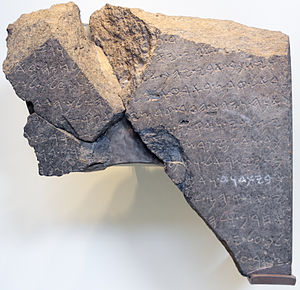Cercu de Tel Dan
La cercu de Tel Dan ye una piedra sobreescrita descubierta ente 1993 y 1994 mientres escavaciones llevaes a cabu en Tel Dan nel norte d'Israel. Ta formada por numberosos fragmentos que formen una inscripción triunfal n'araméu, realizada con toa probabilidá por Hazael del Damascu araméu, una importante figura internacional de finales del sieglu IX a C. Hazael (o más precisamente, el rei que'l so nome nun consta) presume de les sos victories sobre'l rei d'Israel y el so aliáu'l rei de la "Casa de David" (bytdwd), la primer vegada que'l nome de David y la so dinastía foi atopáu fora de la Biblia.[1] La inscripción de Tel Dan xeneró un importante alderique y una socesión d'artículos cuando apaeció, dando pie inclusive a acusaciones de falsificación, "pero reparar anguaño de manera amplia como a) xenuina, y b) relativa a la dinastía de David y al Reinu Araméu de Damascu".[2] Atópase anguaño n'esposición nel Muséu d'Israel, en Xerusalén.[3]
 | |
| Tipu | estela |
|---|---|
| Llocalización |
Museo de Israel (es) |
| Data de descubrimientu | 1993 |
Testu
editarDe siguío recuéyese la trescripción del testu del cercu utilizando calteres n'hebréu tal que fueron facilitaos por Biran y Naveh. Les pallabres separaes por puntos (como nel orixinal), y los espacios en blancu separaos por corchetes indiquen testu estropiáu o faltante, y el testu dientro de corchetes foi reconstruyíu por Biran y Naveh:
1.[ ]א]מר.ע[ ]וגזר ]2.[ ]אבי.יסק[.עלוה.בה]תלחמה.בא--- ]
3.וישכב.אבי.יהך.אל[.אבהו]ה.ויעל.מלכי[ יש]
4.ראל.קדם.בארק.אבי[.ו]יהלך.הדד[.]א[יתי]
5.אנה.ויהך.הדד.קדמי[.ו]אפק.מן.שבע[ת---]
6.י.מלכי.ואקתל.מל[כן.שב]ען.אסרי.א[לפי.ר]
7.כב.ואלפי.פרש.[קתלת.אית.יהו]רם.בר[אחאב.]
8.מלך.ישראל.וקתל[ת.אית.אחז]יהו.בר[יהורם.מל]
9.ך.ביתדוד.ואשם.[אית.קרית.הם.חרבת.ואהפך.א]
10.ית.ארק.הם.ל[ישמן ]
11.אחרן.ולה[... ויהוא.מ]
12.לך.על.יש[ראל... ואשם.]
13.מצר.ע[ל. ]
La siguiente traducción llinia per llinia foi realizada por Lawrence J. Mykytiuk (publicáu en 2004) siguiendo principalmente Biran y Naveh. El testu estropiáu o faltante representar por aciu corchetes vacíos "[ ]" y les pallabres y lletres dientro de los corchetes fueron reconstruyíes. El "Hadad" mentáu nes primeres llinies ye un dios (Los israelites d'esa dómina yeren henoteistas como munchos pueblos vecinos) :
1'. [ ]...[ ] y cortó [ ]
2'. [ ] el mio padre llevantóse [contra él] y lluchó en [...]
3'. Y el mio padre rindióse ; foi colos sos [antepasaos]. Agora el rei d'I[s-]
4'. rael entró na tierra del mio padre antes. [Pero entós] Hadad fíxome rei,
5'. Y Hadad coló delantre de mi. Asina que fui escontra el frente de [los] siete [...]
6'. del mio reináu , y maté a [sete]nta rei[s] qu'habíen enjaezado mil[es de carr]os
7'. y miles de caballos. [Y yo maté a Jo]ram fíu de [Acab]
8'. el rei d'Israel, y yo maté [Aca]yahu fíu de [Joram re]i de
9'. la Casa de David. Y yo llevé [les sos ciudaes en ruines y convertí]
10'. la so tierra en [ablayamientu...]
11'. otros y [...Entós...fíxime re]/i
12'. conducieron sobre Is[rael...Y entós empecé]
13'. asediu contra [...][4]
Ver tamién
editarReferencies
editar- ↑ Finkelstein, 2007, p. 14.
- ↑ Grabbe, 2007, p. 333.
- ↑ «Samuel and Saidye Bronfman Archaeology Wing». The Israel Museum, Xerusalén. Archiváu dende l'orixinal, el 2011-08-12. Consultáu'l 26 de setiembre de 2012.
- ↑ Mykytiuk, 2004, p. 113.
Bibliografía
editar- Athas, George (2005) The Tel Dan Inscription: A Reappraisal and a New Interpretation. Continuum International Publishing Group.
- Brooks, Simcha Shalom (2005). Saul and the Monarchy: A New Look. Ashgate Publishing.
- Collins, John J. (2005). The Bible After Babel. Eerdmans.
- Davies, Philip R., “‘House of David' Built on Sand: The Sins of the Biblical Maximizers.” Biblical Archaeology Review 20/4 (1994).
- Dever, William G. (2001). What Did the Biblical Writers Know and When Did They Know It?. Eerdmans.
- Finkelstein, Israel; Mazar, Amihay; Schmidt, Brian B. (2007) The Quest for the Historical Israel. Society of Biblical Literature.
- Finkelstein, Israel. "State Formation in Israel and Judah: A Contrast in Context, a Contrast in Trajectory" Near Eastern Archaeology, Vol. 62, Non. 1 (Mar., 1999), pp. 35–52.
- Grabbe, Lester L. (2007). Ahab Agonistes. Continuum International Publishing Group.
- Hagelia, Hallvard (2005). «Philological Issues in the Tel Dan Inscription», Current Issues in the Analysis of Semitic Grammar and Lexicon. Otto Harrassowitz Verlag.
- Lemche, Niels Peter (1998) The Israelites in History and Tradition. Westminster John Knox Press.
- Mykytiuk, Lawrence J. (2004). Identifying Biblical Persons in Northwest Semitic Inscriptions of 1200-539 B.C.E.. Society of Biblical Literature.
- Stavrakopoulou, Francesca (2004). King Manasseh and Child Sacrifice. Walter de Gruyter.
- Schmidt, Brian B. (2006). «Neo-Assyrian and Syro-Palestinian Texts I: the Tel Dan Inscription», [https://books.google.com.au/books?id=4tUCnNLGw4UC&pg=PA305&dq=The+Tel+Dan+inscription+%28Schmidt%29&hl=en&sa=X&ei=HlXYT8KUGM2ZiQfuu9CIAw&ved=0CDkQ6AEwAA#v=onepage&q=The%20Tel%20Dan%20inscription%20%28Schmidt%29&f=false The Ancient Near East: Historical Sources in
Translation]. John Wiley & Sons.
- Suriano, Matthew J., “The Apology of Hazael: A Literary and Historical Analysis of the Tel Dan Inscription,” Journal of Near Eastern Studies 66/3 (2007): 163-76.